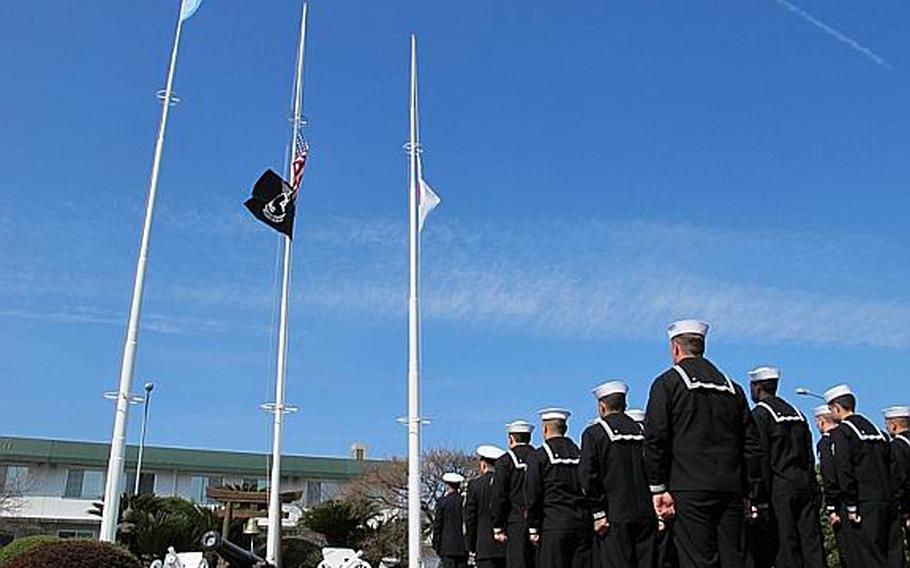
About 40 sailors from various commands along with base leadership gathered at Sasebo Naval Base's Lt. Daniel Godsoe Plaza on the afternoon of March 11, 2013, to commemorate the massive earthquake and tsunami that rocked Japan on March 11, 2011, and honor its victims. Many sailors from the small base in southern Japan deployed as a part of rescue and recovery efforts. (Matthew M. Burke/Stars and Stripes)
Military bases in Japan paused at 2:46 p.m. Monday in remembrance of the nearly 19,000 people who died two years ago during the earthquake and tsunami that decimated much of the country’s eastern coast.
Commemorations of the March 11, 2011, disaster were generally brief and somber.
Servicemembers at Naval Air Facility Misawa, in the northeast of Japan’s main island of Honshu, saluted as snow fell on the Japanese and U.S. flags, each lowered to half-mast. Airmen at Yokota Air Base, soldiers at Camp Zama and sailors aboard various ships in the Navy’s 7th Fleet observed moments of silence.
Military officials said they generally followed the lead of the Japan Self-Defense Force, which held similar moments of reflection.
At Sasebo Naval Base, about 40 sailors from various commands and base leadership gathered by the flagpoles in Lt. Daniel Godsoe Plaza.
They stood at attention in their dress uniforms for several minutes while the lowered flags flapped in a chilly wind. A crowd of civilians, including Japanese base employees, gathered across the street while sirens could be heard from town.
Yano Masahiro, a Japanese civilian employee in the base’s safety department, said he heard about the observance and came running.
“It’s kind of sad,” Masahiro said. “So many people died… We are very happy the American people still remember 3/11.”
Command Master Chief Christopher Stone noted the commemoration’s importance in maintaining ties between the U.S. and Japan.
Stone also noted that the Japanese turn out for observances of the anniversary of the 9/11 terrorist attacks, which has meant a lot to him.
“They feel our pain, and we feel their pain,” Stone said. “It is a good time to take a pause… They know we’re always going to be there for them.”
Okinawa-based Marines visited Kesennuma city and Oshima Island on Monday, where they participated in memorial services and later were scheduled to hold a concert by the 3rd Marine Expeditionary Force band.
Shortly after the earthquake, Marines from Okinawa arrived on Oshima, about 240 miles north of Tokyo, to assist with cleanup efforts. In January, Marines hosted Oshima children in Okinawa as part of a cultural exchange program.
The U.S. military took an active role in the weeks following the magnitude 9 earthquake, tsunami and subsequent Fukushima nuclear accident. Under Operation Tomodachi, more than 20,000 U.S. troops were involved in rescue, humanitarian aid and clean-up, working together with Japan’s Self-Defense forces.
Stars and Stripes reporter Matthew M. Burke contributed to this report.